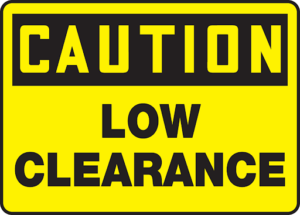
RV Route Red Flags
Do you need a quick A/C removal, maybe a one sweep roof removal? Try a low overpass –

But if you want to give people like me one less RV disaster to laugh at, we’ve got some red flags for you to watch out for when planning your trip. But, like a low clearance sign, it’s your choice or not to listen.
First, those low bridges and overpasses; know the height of your RV (including anything on top like A/C, storage, etc) so you have your clearance in mind for passing under bridges and overpasses. Check the height (and weight) restrictions for any of those along your route so you can choose an alternative if necessary.
One resource you can check is this document listing Alberta bridge clearances on the Primary Highways

Another is an RV GPS or app like RV Life GPS. (RV Life: Free; RV Life Pro $65 a year (as of February 2024).
No Bull Tip! A lot of RV GPS apps are crowd sourced information, so it can be worth double checking with different sources if you’re going down an unfamiliar route.
And while you’re doing that check for overly curvy and/or steep roads. Only you know how comfortable you are driving narrow, winding roads with your RV but a good rule of thumb is the longer the RV = the wider the turns. Best opt for routes with wider roads, less sharp curves, and fewer steep inclines/declines as possible.
Next on your checklist is RV friendly gas stations. The average gas station may not always have the space for larger RVs. And particularly if you’re heading an unfamiliar direction checking for gas stations that can accommodate your rig. Mapping ahead for refuels can help you from panicking about a low tank.
No Bull Tip! Parents, make sure you plan rest stops according to how much travel your kids can take at a time. That means potty breaks, meals, time to stretch their legs, maybe run around a playground. And account for pets too!
RV Horror Story: One of our staff recalled a trip where their car-terrified dog was brought along. The poor thing got sick! Luckily, she waited until after she leapt out of the car to do her business or that would’ve been one smelly road trip.


Also check for dump stations and water fill stations when planning fuel-ups.
Your holding tanks need to be emptied regularly to maintain a sanitary and functioning RV. Going long times between dumps can lead to plumbing issues, bad smells, and possible health hazards.
Watch out for dump stations where the water refill is right beside it. Often less-hygenic RVers will use the fresh water hose to rinse out their black tank spout or hose at the same time. Inspect fresh water fill stations in public areas like this for any sign of misuse.
No Bull Tip! To help avoid the issue known as a poop mountain here’s what you do: make sure your outside valve is closed on the black tank then put about a gallon or two of water straight into the tank via the toilet (it’s located right above the holding tank in most RVs so all you have to do is pour) to give you a layer of water that will slosh around as you drive. (We also recommend using a toilet chemical)
When choosing your route, country roads don’t always take you home. I can’t tell you what to do, but I can recommend avoiding ill-maintained roads that lack proper signs or have limited services. You can end up in a bad situation and be hard to find by emergency services, roadside assistance, or just have no cell-service at all.
Which, speaking of: cell service. While you can download GPS routes on apps like Google Maps, having your phone drop out in an emergency is literally a panic worthy situation. Consider a cell phone booster if you know you’ll be in an area with no service for a long time, and maybe a map or even road atlas tossed in the trunk.
We’ve got another list of some of the dumbest mistakes an RVer can make but we’ll finish off here with 3 honorable mentions when planning your driving days:
- Crossing bridges with the propane one. While we don’t recommend driving with your propane on at all, there are some bridges and crossings where having your propane on is strictly prohibited.
- Border crossings. If you’re heading into the States make sure you have all the correct documentation on hand. Many regulations have changed since the pandemic so know what you need before you go or you can be turned away.
- Toll Roads. These aren’t common in Canada, in fact you’ll only have to deal with the majority of them at the Canada/US border. If you’re crossing over to our southern neighbors, that’s when you’ll want to be more aware; be prepared to pay if you do end up at one of the few across the land of the true north strong and free.
Is there anything we forgot to mention that you always plan for on your driving days? Let us know!

